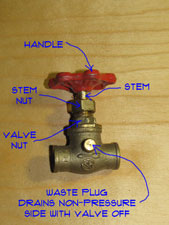 A water shut off valve leaking can make a mess and waste water. Water shut off valves can also leak at various points on the valve. For instance, a standard stop and waste valve has three other washers that can leak in addition to the washer that shuts the water off.
A water shut off valve leaking can make a mess and waste water. Water shut off valves can also leak at various points on the valve. For instance, a standard stop and waste valve has three other washers that can leak in addition to the washer that shuts the water off.
Not sure if this is your problem? See the articles 'Troubleshooting Water Pipes' and 'Home Plumbing Repair' for a listing of related topics.
Leaks at the Valve Stem
The valve stem is the part the has the handle attached to it. There is a nut underneath the handle that holds the stem in place.
Most valves have a washer that seals the stem from leaking. The nut that keeps the stem aligned is the one that is most likely to leak. This is especially true if the valve gets used regularly. The opening and closing of the valve can loosen the nut over time.
When this happens, it is likely that tightening the nut will solve the problem. Use a crescent wrench to tighten the nut. Try not to over tighten it.
Leaks at the Stop and Waste Cap
Some valves have a small drain on the side that can also leak. Since these washers do not see a lot of action they are less prone to problems. However, they do leak if the nuts are not kept tight.
The stop and waste cap does not have a hex fitting on it, so you will have to use a pair of pliers or channel locks to tighten it. Use the pliers to turn the cap clockwise until it feels snug. This should stop the leak.
If this does not work, there is a small washer on the inside of the cap that can be replaced. Or you can get a new cap with a washer on the inside. Install the cap with a new washer and snug it up. This should solve the problem.
Leaks at the Valve Body Nut
The valve is made of two components, the stem assembly and the valve flow body. The nut that holds the tow pieces together can leak, although this is not that common.
If you do have a leak at this location you can use an adjustable wrench or pipe wrench to tighten it. This is a machined fitting so when it is tight it will lock in place and will not go any farther.
Shut Off Washer Leaking
You usually only notice this when you shut the valve off. Many valves get used rarely, so you don't realize that they won't shut the water off completely. If the water continues to run even with the valve off, you have a bad washer.
To replace the washer, you need to take the valve apart at the valve body nut. The valve will come apart in two pieces. The washer is held in place by a brass screw. You will need to get one that is the same size. Install the new washer and replace the stem assembly in the valve body.
With a new washer in place you should be able to shut the valve off and not have water trickling or flowing through it.

